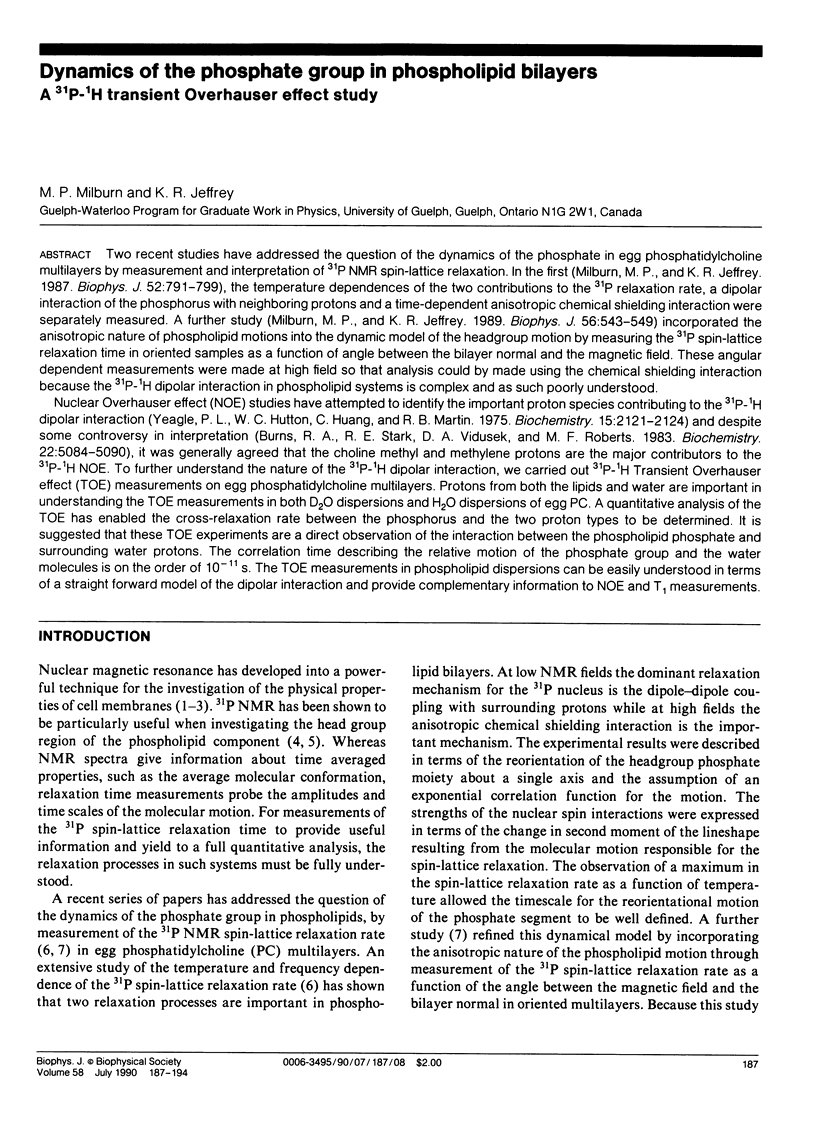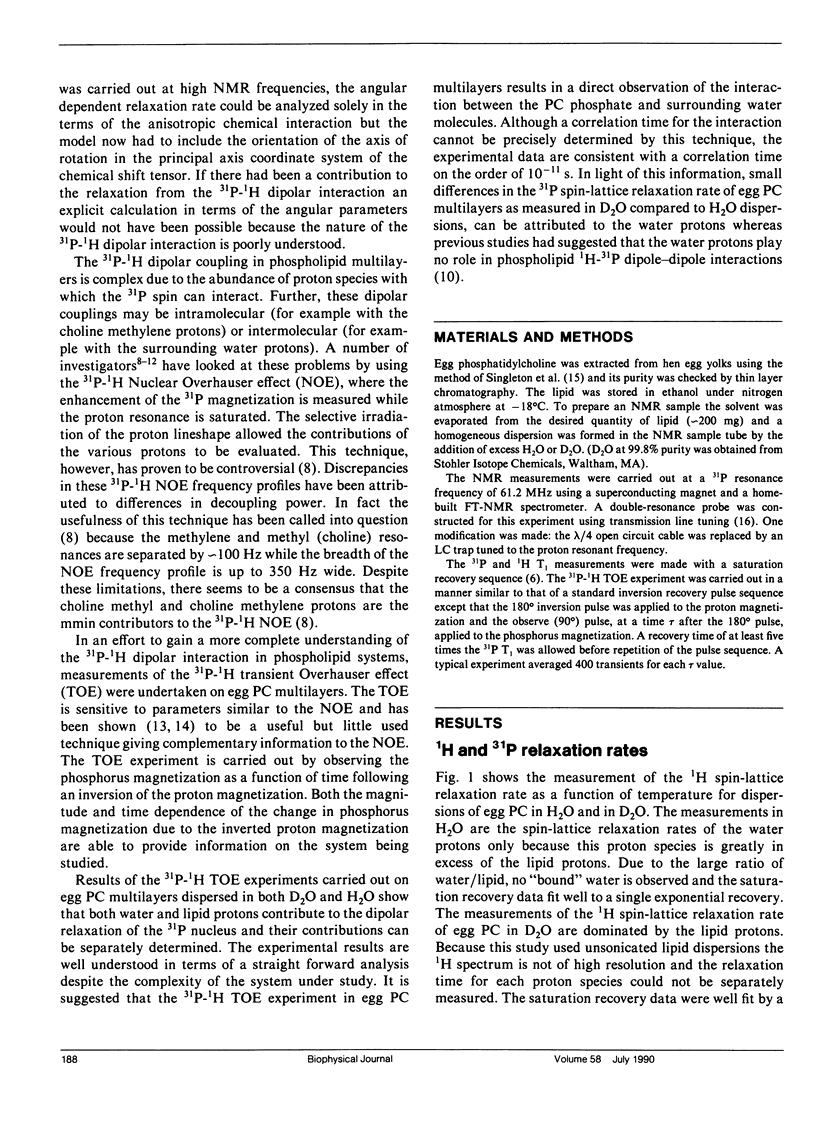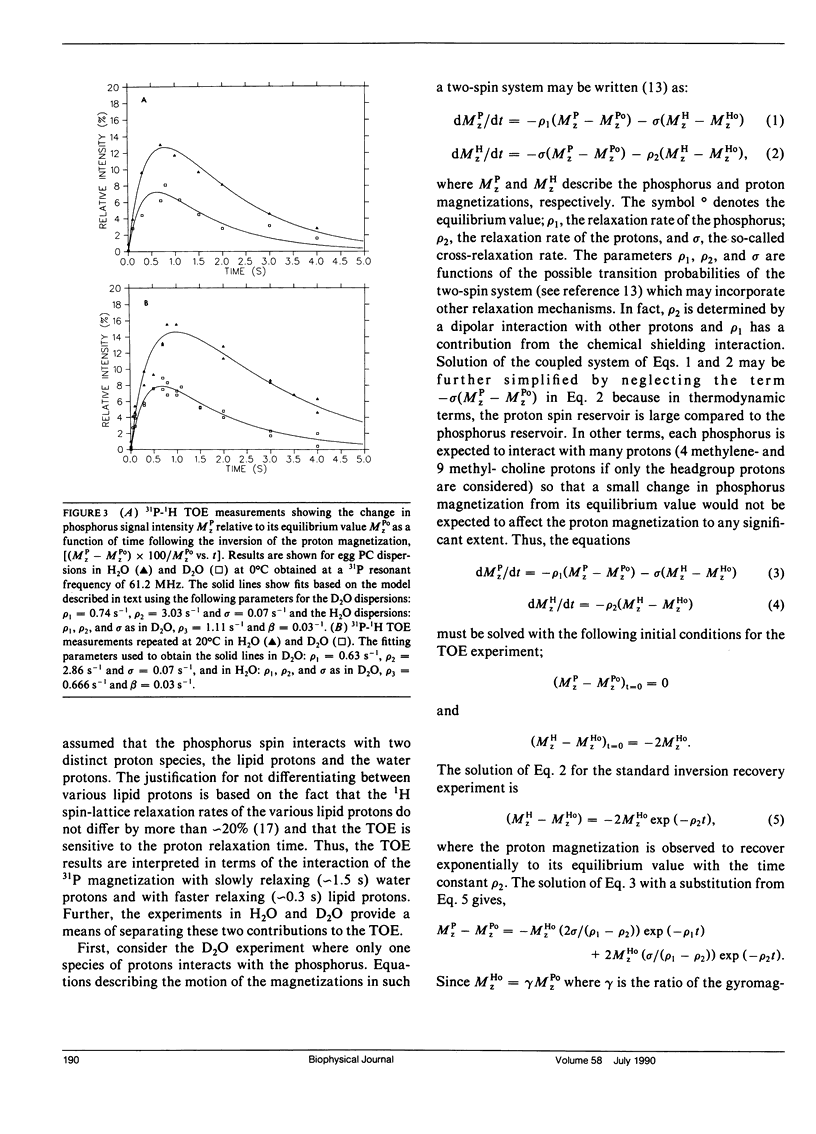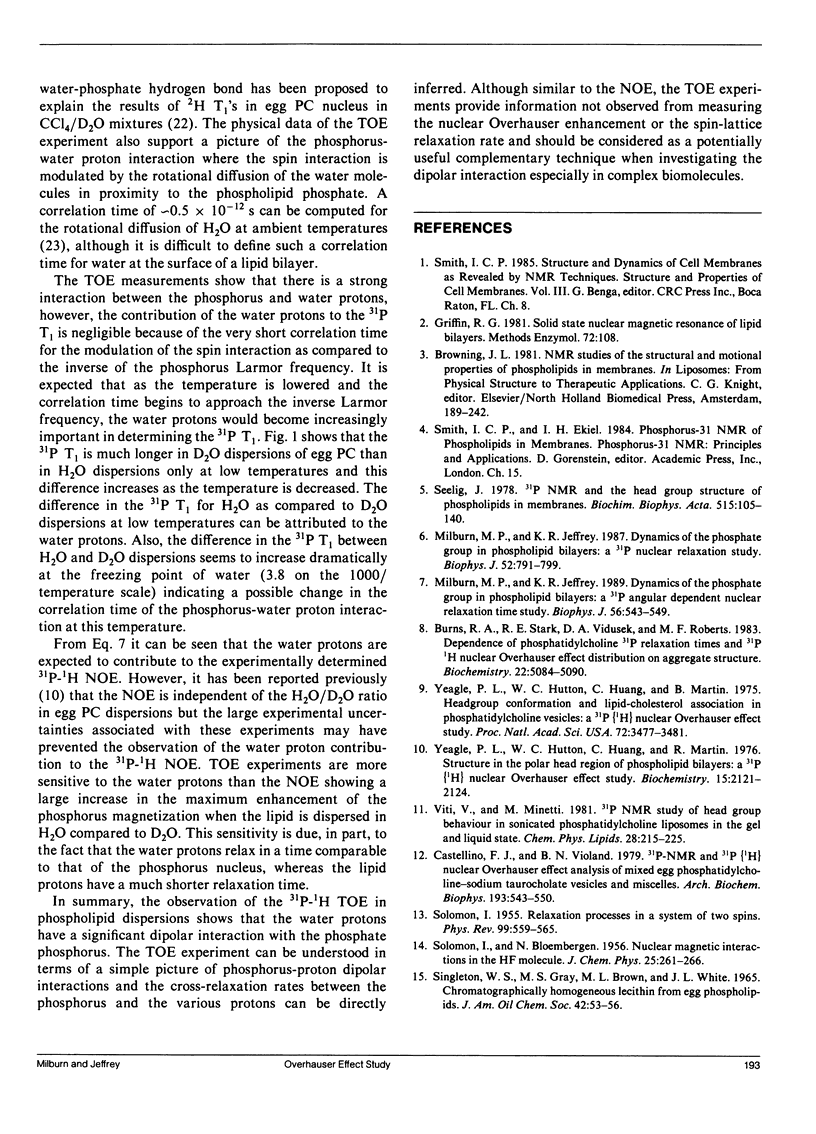Abstract
Two recent studies have addressed the question of the dynamics of the phosphate in egg phosphatidylcholine multilayers by measurement and interpretation of 31P NMR spin-lattice relaxation. In the first (Milburn, M. P., and K. R. Jeffrey. 1987. Biophys. J. 52:791-799), the temperature dependences of the two contributions to the 31P relaxation rate, a dipolar interaction of the phosphorus with neighboring protons and a time-dependent anisotropic chemical shielding interaction were separately measured. A further study (Milburn, M. P., and K. R. Jeffrey. 1989. Biophys. J. 56:543-549) incorporated the anisotropic nature of phospholipid motions into the dynamic model of the headgroup motion by measuring the 31P spin-lattice relaxation time in oriented samples as a function of angle between the bilayer normal and the magnetic field. These angular dependent measurements were made at high field so that analysis could by made using the chemical shielding interaction because the 31P-1H dipolar interaction in phospholipid systems is complex and as such poorly understood. Nuclear Overhauser effect (NOE) studies have attempted to identify the important proton species contributing to the 31P-1H dipolar interaction (Yeagle, P. L., W. C. Hutton, C. Huang, and R. B. Martin. 1975. Biochemistry. 15:2121-2124) and despite some controversy in interpretation (Burns, R. A., R. E. Stark, D. A. Vidusek, and M. F. Roberts. 1983. Biochemistry. 22:5084-5090), it was generally agreed that the choline methyl and methylene protons are the major contributors to the 31P-1H NOE. To further understand the nature of the 31P-1H dipolar interaction, we carried out 31P-1H Transient Overhauser effect (TOE) measurements on egg phosphatidylcholine multilayers. Protons from both the lipids and water are important in understanding the TOE measurements in both D20 dispersions and H20 dispersions of egg PC. A quantitative analysis of the TOE has enabled the cross-relaxation rate between the phosphorus and the two proton types to be determined. It is suggested that these TOE experiments are a direct observation of the interaction between the phospholipid phosphate and surrounding water protons. The correlation time describing the relative motion of the phosphate group and the water molecules is on the order of 10- 11 s. The TOE measurements in phospholipid dispersions can be easily understood in terms of a straight forward model of the dipolar interaction and provide complementary information to NOE and T1 measurements.
Full text
PDF







Selected References
These references are in PubMed. This may not be the complete list of references from this article.
- Boggs J. M. Effect of lipid structural modifications on their intermolecular hydrogen bonding interactions and membrane functions. Biochem Cell Biol. 1986 Jan;64(1):50–57. doi: 10.1139/o86-008. [DOI] [PubMed] [Google Scholar]
- Boggs J. M. Lipid intermolecular hydrogen bonding: influence on structural organization and membrane function. Biochim Biophys Acta. 1987 Oct 5;906(3):353–404. doi: 10.1016/0304-4157(87)90017-7. [DOI] [PubMed] [Google Scholar]
- Castellino F. J., Violand B. N. 31P-nuclear magnetic resonance and 31P(1H) nuclear Overhauser effect analysis of mixed egg phosphatidylcholine-sodium taurocholate vesicles and micelles. Arch Biochem Biophys. 1979 Apr 1;193(2):543–550. doi: 10.1016/0003-9861(79)90061-4. [DOI] [PubMed] [Google Scholar]
- Feigenson G. W., Chan S. I. Nuclear magnetic relaxation behavior of lecithin multilayers. J Am Chem Soc. 1974 Mar 6;96(5):1312–1319. doi: 10.1021/ja00812a009. [DOI] [PubMed] [Google Scholar]
- Fung B. M., McAdams J. L. The interaction between water and the polar head in inverted phosphatidylcholine micelles. A 2H and 31P relaxation study. Biochim Biophys Acta. 1976 Nov 18;451(1):313–320. doi: 10.1016/0304-4165(76)90281-6. [DOI] [PubMed] [Google Scholar]
- Griffin R. G. Solid state nuclear magnetic resonance of lipid bilayers. Methods Enzymol. 1981;72:108–174. doi: 10.1016/s0076-6879(81)72010-x. [DOI] [PubMed] [Google Scholar]
- Horwitz A. F., Horsley W. J., Klein M. P. Magnetic resonance studies on membrane and model membrane system: proton magnetic relaxation rates in sonicated lecithin dispersions. Proc Natl Acad Sci U S A. 1972 Mar;69(3):590–593. doi: 10.1073/pnas.69.3.590. [DOI] [PMC free article] [PubMed] [Google Scholar]
- Lee A. G., Birdsall N. J., Levine Y. K., Metcalfe J. C. High resolution proton relaxation studies of lecithins. Biochim Biophys Acta. 1972 Jan 17;255(1):43–56. doi: 10.1016/0005-2736(72)90006-5. [DOI] [PubMed] [Google Scholar]
- Milburn M. P., Jeffrey K. R. Dynamics of the phosphate group in phospholipid bilayers. A 31P angular dependent nuclear spin relaxation time study. Biophys J. 1989 Sep;56(3):543–549. doi: 10.1016/S0006-3495(89)82701-8. [DOI] [PMC free article] [PubMed] [Google Scholar]
- Milburn M. P., Jeffrey K. R. Dynamics of the phosphate group in phospholipid bilayers. A 31P nuclear relaxation time study. Biophys J. 1987 Nov;52(5):791–799. doi: 10.1016/S0006-3495(87)83273-3. [DOI] [PMC free article] [PubMed] [Google Scholar]
- SINGLETON W. S., GRAY M. S., BROWN M. L., WHITE J. L. CHROMATOGRAPHICALLY HOMOGENEOUS LECITHIN FROM EGG PHOSPHOLIPIDS. J Am Oil Chem Soc. 1965 Jan;42:53–56. doi: 10.1007/BF02558256. [DOI] [PubMed] [Google Scholar]
- Seelig J. 31P nuclear magnetic resonance and the head group structure of phospholipids in membranes. Biochim Biophys Acta. 1978 Jul 31;515(2):105–140. doi: 10.1016/0304-4157(78)90001-1. [DOI] [PubMed] [Google Scholar]
- Yeagle P. L., Hutton W. C., Huang C. H., Martin R. B. Headgroup conformation and lipid--cholesterol association in phosphatidylcholine vesicles: a 31P(1H) nuclear Overhauser effect study. Proc Natl Acad Sci U S A. 1975 Sep;72(9):3477–3481. doi: 10.1073/pnas.72.9.3477. [DOI] [PMC free article] [PubMed] [Google Scholar]
- Yeagle P. L., Hutton W. C., Huang C. H., Martin R. B. Structure in the polar head region of phospholipid bilayers: A 31P [1H] nuclear Overhauser effect study. Biochemistry. 1976 May 18;15(10):2121–2124. doi: 10.1021/bi00655a014. [DOI] [PubMed] [Google Scholar]


